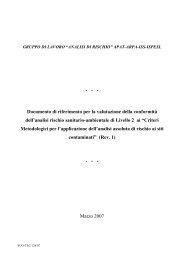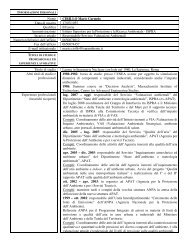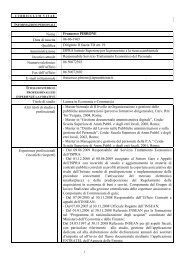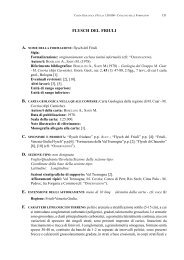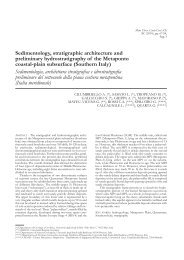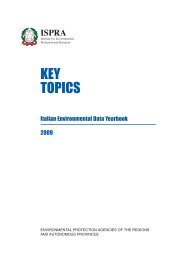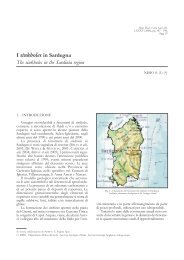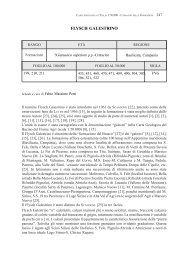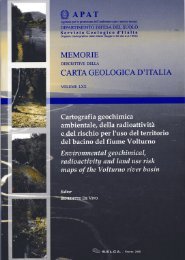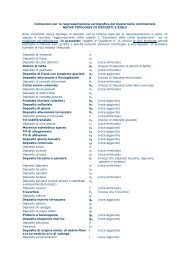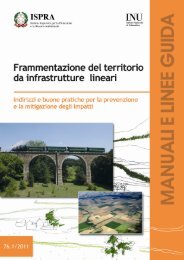Guidebook - Ispra
Guidebook - Ispra
Guidebook - Ispra
You also want an ePaper? Increase the reach of your titles
YUMPU automatically turns print PDFs into web optimized ePapers that Google loves.
THE APULIA CARBONATE PLATFORM-MARGIN AND SLOPE, LATE JURASSIC TO<br />
EOCENE OF THE MAIELLA MT. AND GARGANO PROMONTORY:<br />
PHYSICAL STRATIGRAPHY AND ARCHITECTURE P18<br />
Figure 2 - The eastern margin (Jurassic-Lower Cretaceous) of the Apulia Platform, with interpreted scalloped<br />
structures, compiled from outcrops and subsurface data (modifi ed after Bosellini et al., 2000).<br />
exists as regard the possible connection of the ACP<br />
with the African continent (see Bosellini, 2002 for<br />
discussion and general bibliography).<br />
The initial separation between the ACP and adjacent<br />
basinal areas is another open question. This separation<br />
is well documented starting from the Liassic, even<br />
though the beginning of the extension and the<br />
continental crustal thinning, linked to the Tethyan<br />
rifting is probably more ancient. This interpretation<br />
is suggested by the Lower Triassic basinal sediments<br />
(M. Facito Fm) of the Lagonegro Basin and by the<br />
highly different sedimentation rates recorded in the<br />
adjacent depositional areas of the Dolomia Principale<br />
(45 m/Ma as average) and of the Anidriti di Burano<br />
or equivalents (200 m/Ma as average), which indicate<br />
subsidence rates compatible with rifting regimes<br />
(Finetti, in press; Finetti et al., in press).<br />
The margin of the ACP is mostly buried under<br />
Tertiary and Quaternary deposits, but it can be well<br />
drawn from subsurface and outcrops data. To the<br />
southeast, the ACP margin is still perfectly preserved<br />
and not affected by strong compressive tectonics. It<br />
lies 20-30 km east of the present Apulia coast line<br />
(De Dominicis and Mazzoldi, 1989; De Alteriis and<br />
Aiello, 1993) (Figure2). To the northwest, about 15<br />
km from the present Abruzzo coastal line, the ACP<br />
margin turns of about 90° and strikes in a SW direction<br />
toward the folded and thrusted units of the Lazio-<br />
Abruzzo area. The ACP margin is characterized by an<br />
overall aggrading or slightly prograding architecture,<br />
characterised by different geometric and depositional<br />
features along its extent. In some areas, a depositional<br />
margin characterizes the platform to basin transition,<br />
with a 20° to 30° dipping slope extending for about<br />
4-6 km basinward, from the platform break; in<br />
this case, bio-intraclastic deposits and breccias are<br />
exported downslope and drape the Liassic normal<br />
faults (Figure3). In other areas, the platform margin<br />
is characterized by an abrupt escarpment, recording<br />
an evolution from erosive to depositional conditions<br />
during the Late Cretaceous and Tertiary. Here, typical<br />
geometric and depositional features are represented<br />
by faults, scallops, large-scale onlaps and huge<br />
amount of breccias and megabreccias. This second<br />
type of margin setting characterises discrete portions<br />
of the ACP from south to north, both in subsurface<br />
(offshore of Brindisi, Bari and Ortona) and in outcrops<br />
(Gargano and Maiella areas) (Figure2). This fi eld trip<br />
will deal with both types of margin.<br />
The geological framework of the<br />
Maiella Mountain<br />
The Maiella Mt. represents the most spectacular<br />
outcropping folded and thrusted structure of the<br />
external Abruzzi Apennines, and derives from the<br />
deformation of the internal sectors of the ACP<br />
5 - P18<br />
Volume n° 3 - from P14 to P36



